White Sox Season Review: Grading the Starting Pitching

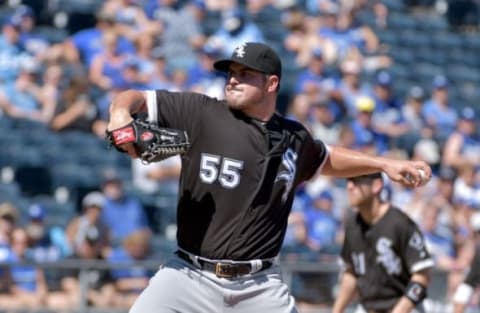
White Sox starting pitching ranked 14th in MLB in 2016. With two All-Star starters at top of rotation, lack of depth ultimately hurt starting group.
Now that the Chicago White Sox season is over, it is time to analyze each position on the Sox roster for 2016. Grading this is going to be subjective to some extent, mostly due to the fact there are many factors to take into account. The reason for that is because there are players that got released during the season in Mat Latos and John Danks.
More often than not, when a team finishes below .500 there are not very many strong spots to the team. However, that is not the case with the Sox. The starting pitching staff boasted two All-Stars, not to mention other strong members. While the Sox benefited from an okay season from a former first round pick, they also dealt with a struggling veteran who should have never been acquired. With the season in the record books, its time to hand out grades for each Sox starting pitcher. So, let’s take a look:
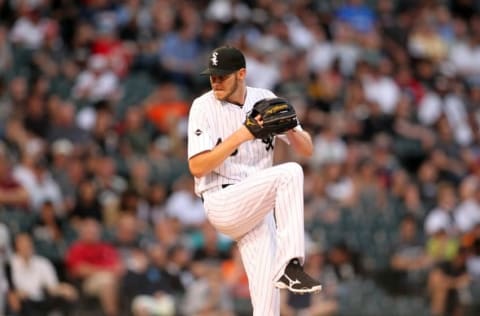
Chris Sale: (A)
For the fifth consecutive season, Sale made the American League All-Star team. His final record was 17-10, with an ERA of 3.34. On top of that, Sale struck out 233 while only issuing 45 free passes. To help you understand his strikeout total, hitters failed to make contact on 73.13 percent of his sliders (on swings) down and in to righties (or low and away to lefties).
As for Sale’s velocity, it stayed around the same for all of 2016. His average fastball was just below 94 MPH, not to mention his changeup lost velocity during the season (from 86 down to 84-85 range). The slider was in the 78-79 MPH range all season. The difference between fastball and changeup is another reason for the high strikeout total. That 8-10 MPH difference is very good, not to mention his slider makes him very tough to hit.
Sale has established himself as one of the elite pitchers in the game. Even though he is unlikely to win the Cy Young, there isn’t a single team in all of baseball who wouldn’t want him on their staff. The Sox have a true ace on their roster, and whatever they choose to do with him this off-season is up to them, however he is among the most valuable assets in the game. I say that because if they due trade him, they will get a huge haul in return.
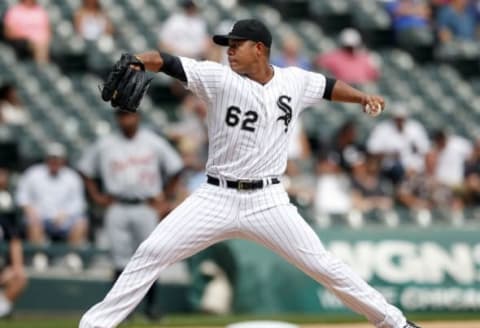
Jose Quintana: (A)
Quintana appeared in his first All-Star game in 2016, an honor that has been long overdue. On top of that, he reached double digits in wins for the first time in his career, as he posted a 13-12 record and a 3.20 ERA. While Quintana did not have the eye-popping BB/K numbers that Chris Sale posted, they were very good nonetheless. He only walked 50, and fanned 181 batters.
One interesting part of Quintana’s game is that when he throws his changeup, it is predominantly against right-handed batters. He only threw it to lefties in April, June, and July, however used it versus the righties in all months during the 2016 season. The changeup stayed in the 86-87 MPH range the whole season (vs all batters), which is only about six MPH off of his fastball, which sits around 92-93 MPH.
To sum up Quintana’s season, he finally got over the hump of becoming a legit big-time starter in the major leagues. While he is still not at the level of a Clayton Kershaw or fellow teammate Sale, his no decision total went down from 2015 (13 to seven). The Sox have two of the best lefties in the game, and under control for a number of years. It should be fun to watch these two pitch on the South Side.

Carlos Rodon (C+)
While Rodon was a breakout candidate heading into the 2016 season, he failed to live up to the billing. Rodon’s ERA actually fell in 2016, as it was 4.04 compared to 3.75 in 2015. However, his walk total dropped, which is critical considering the fact he walked 17 fewer batters this past season (54 instead of 71) while pitching 165 innings. That is key when he only threw 139.1 IP in 2015.
Another area that Rodon worsened in this season was the win/loss column. In his rookie season, he went 9-6 however this season Rodon finished below .500 at 9-10. Strikeouts went north in 2016, increasing from 139 in 2015 to 168 in this season. One issue was the fact he allowed 23 home runs this past year, compared to 11 in 2015.
Rodon’s fastball velocity increased later in the season. His maximum fastball velocity was 99 MPH in August and September, and both months had the highest fastball velocity of any month (Rodon hit 99 MPH in June). To top it off, August and September had the highest fastball velocity average. Rodon was 7-2 in those two months. Coincidence, maybe?
If Rodon wants to become an elite pitcher, he needs to work on his fastball. If he can make this a plus pitch, and I am not just talking about velocity he can be an All-Star. Until then, he will have a hard time being more than a solid third starter in the major leagues.
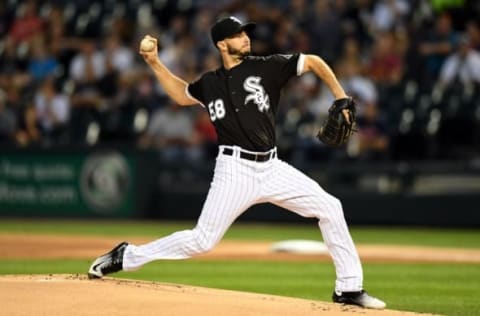
Miguel Gonzalez (B-)
This was a steal for the White Sox when they picked up Gonzalez off of the scrap heap in April. He went on to have an solid season for the South Siders, as he posted a 5-8 record with a 3.73 ERA. His BB/K rate was nearly 3/1 (in favor of K’s), with 95 K’s and 35 BB’s.
Gonzalez was let go for one reason, the Baltimore Orioles thought his velocity was dropping. Since he was struggling to touch 90 MPH, something Gonzalez needs to do in order to win, the Orioles let him go. However, his velocity increased when he came to Chicago, as did his fastball. His average fastball was in the 90-92 range, which he is capable of pitching at.
The Sox could end up getting a steal in Gonzalez, and 100% free. No prospects dealt away, no big contract to worry about, nothing. He is making basically league minimum. This is why the Sox pitch well most every season. They know how to recognize talent when there is some left. Which Gonzalez still has.
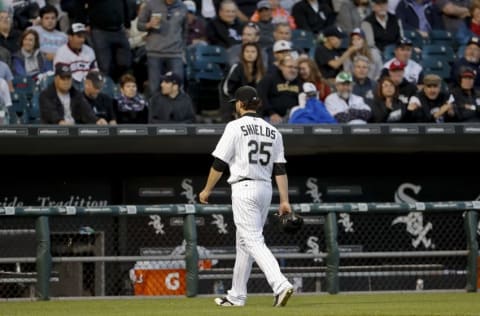
James Shields (C- with Padres, F with White Sox)
The Sox paid dearly when acquiring Shields, not in prospects but in performance from the number five spot in the rotation. With the Sox, Shields went 4-12, and had two months with an ERA over 11.00. His overall ERA with the Sox was 6.77, making him among the worst pitchers in the American League during that time.
For much of Shields career, he has had an average fastball/changeup difference of 8-10 MPH. Now, there is hardly a 6-7 MPH difference. On top of that, Shields fastball has decreased in velocity from 93-94 MPH in 2014 to 90-91 MPH this past season. The drop in velocity, plus a minor but large difference in his fastball and changeup will be key going forward for Shields.
Shields contract is very likely to become an albatross for the Sox, assuming he doesn’t develop elite fastball command. If Shields is unable to do that, expect another John Danks on the South Side. Something the Sox do not want to see for the next two seasons.
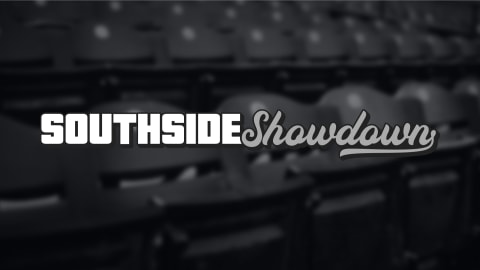
All others (D-)
With a cast off Latos, Danks, and Anthony Raunado among others, the Sox had its fair share of good, but mostly poor starts. Danks was released after four starts, where he went 0-4 with an 7.25 ERA. After a sizzling April, Latos fell apart. He went 4-0 with a 1.84 ERA and allowed a .218 batting average against, but tailspinned downward and ended up with a 6-2 record and 4.62 ERA by June 7.
Others, such as Raunado pitched sparsely, and for the most part not very effectively. Raunado had an ERA north of eight (8.46), and others such as Erik Johnson spent little time with the club. Johnson was a part of the deal that brought Shields over from the Padres.
Overall (B)
The Sox have a good staff, regardless of how much attention is paid to the struggles of Shields. Unfortunately, they will have a hard time winning when Shields goes to the mound over the next two seasons, making it hard for them to compete. Therefore, Sale and Quintana have to pick up the slack in a huge way. Which still puts the Sox behind the eight ball trying to win a division title.
Just to wrap things up, this rotation has four of five spots filled with solid pitchers. The one problem, which I eluded to in the previous paragraph Shields. The Sox would have to win three out of every four starts those pitchers make, assuming Shields continues his rapid decline.
So, if the Sox want to win in the near future, find a way to get Shields out of the rotation. Keep in mind San Diego is paying some of his contract, giving them some ability to eat it. But, it is unlikely the Sox do that. Shields competitiveness and past history has been great, but he is done moving forward. Expect another fifth day of Danks-esque type pitching, Sox fans.